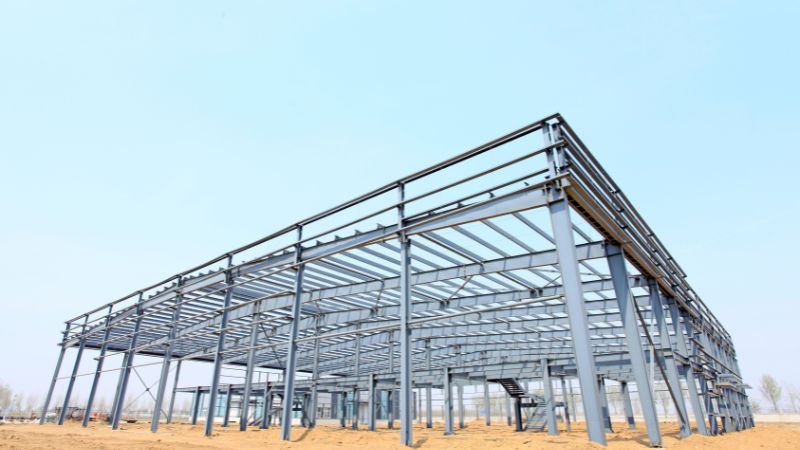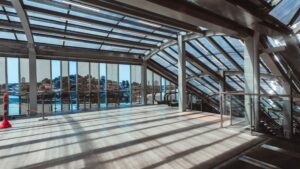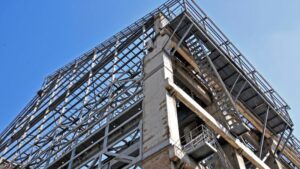Definition of Steel Structure
A steel structure is a framework made mainly with steel parts. These frameworks hold up buildings, bridges, towers, and other large structures in everyday life.
Key Characteristics
Steel structures are known for strength and durability. Steel can carry heavy loads without bending or breaking. Buildings that use steel frames can be taller and larger than those made with wood or concrete.
Steel does not burn, so it offers better fire resistance than some other materials. It is also flexible which means it can handle wind, earthquakes, and vibrations better.
Steel parts are made in factories. This makes construction faster at the building site.
Summary Table: Key Traits of Steel Structures
| Characteristic | Benefit |
| High Strength | Supports heavy weights |
| Fire Resistance | Safer during fire incidents |
| Flexibility | Stands up to earthquakes |
| Speedy Assembly | Faster construction |
Types of Steel Used
The most common is structural steel. This is a special mix of iron and carbon, designed to be strong and easy to work with.
You might also see stainless steel in places needing protection from rust or harsh weather. Alloy steels are sometimes used for extra toughness. They mix steel with elements like chromium or nickel.
The type of steel affects how long your structure will last and how much it can hold. Builders choose the type based on the structure’s job, the climate, and the budget. Each type has its own level of strength, cost, and resistance to damage.
List of Common Types:
- Structural steel (most buildings)
- Stainless steel (for outdoor or wet areas)
- Alloy steels (for high strength needs)
Common Uses
Tall office buildings, sports stadiums, and skyscrapers rely on steel frames so they can reach impressive heights. Bridges often use steel because it holds up to cars, trains, and weather.
Many factories and warehouses use steel because it’s quick to assemble and strong. Smaller uses include houses, garages, and sheds. Steel also supports towers, radio masts, and even some large artworks in public spaces.
Examples of Steel Structure Uses
| Area | Application |
| Buildings | Offices, homes, schools |
| Infrastructure | Bridges, towers, masts |
| Industry | Warehouses, factories |
| Other | Garages, stadium roofs |
Components of Steel Structures
Beams and Columns
Beams are the main horizontal members in a steel structure. They carry loads from the floors, walls, or roofs and transfer them to columns. Beams are often shaped as I-beams or H-beams due to their strength and efficiency.
Columns are the vertical parts that hold up the weight of the structure above. They help transfer the load down to the foundation. Columns need to be placed carefully and sized correctly to stop buckling or bending.
In most steel buildings, you’ll find different types of beams and columns that are chosen based on the building’s height, width, and use. Here is a quick table of common shapes:
| Member | Common Shapes | Main Function |
| Beams | I-beam, H-beam | Support floors/roofs |
| Columns | Tube, Pipe, I-beam | Carry vertical loads |
Working together, beams and columns create the framework or skeleton of steel buildings.
Connections and Joints
Connections and joints are where steel members meet. These can be welded, bolted, or sometimes riveted. Welded connections involve melting pieces of steel together, creating a strong, seamless joint.
Bolted connections use high-strength bolts to hold parts in place. These are often easier to assemble and take apar.
Connections need to be designed carefully to handle all the forces the building may face, like wind or moving loads.
Clear markings and tight tolerances ensure that each connection fits as planned, adding safety and reliability to the whole structure. Good connections are key to preventing damage where parts meet.
Bracing Systems
Bracing systems help keep steel structures upright when strong forces such as wind or earthquakes push on them. Bracing can be diagonal bars, cross-bracing, or even solid steel walls. These systems stop the building from swaying or tipping over.
Bracing is often placed in walls, between columns, or hidden in ceilings. The pattern and material used can change depending on the building’s size, height, or location.
Design Principles
Load-Bearing Considerations
You must consider how the structure will support different types of loads. These loads include the weight of the building itself (dead load), items inside (live load), and outside forces like wind and earthquakes. Each load can affect the building in a unique way.
Tips for managing loads:
- Use sturdy columns and beams for heavy loads.
- Reinforce spots where different loads may combine.
- Check for weak points, especially at connections.
Structural Analysis
Structural analysis helps you know how your design will perform under real-world conditions. You use math and computer tools to test how the steel frame reacts to loads, movements, and even temperature changes.
Most design programs let you build a model of your structure. You enter details about materials, shapes, and forces, then see if anything is overstressed or will shift too much. This helps you find solutions before you build.
It’s important to analyze not just single parts, but also how entire systems work together. Check that columns stay straight, beams don’t bend, and connections hold firm under stress. Modern analysis helps you refine your design for safety and cost savings.
Maintenance and Longevity
Taking care of a steel structure is important if you want it to last a long time. With regular maintenance, a steel building can often stand strong for 50 to 100 years.
Here are some simple steps you can follow for maintaining your steel structure:
- Inspect your building at least once a year.
- Look for signs of rust, corrosion, or loose bolts.
- Clean dirt, dust, and debris off the metal surfaces.
- Repaint or touch up any scratched or chipped areas.
Weather and location can impact how often you need to check things. If you live in a humid or coastal area, look for rust more often because salty or moist air can speed up corrosion.
| Common Issues | Quick Tips to Fix |
| Rust spots | Sand and repaint |
| Loose bolts | Tighten or replace them |
| Leaks | Check and seal joints |
| Dirt buildup | Wash with mild soap |
Steel is strong and can handle lots of weather changes. Still, a little care goes a long way. By keeping up with small repairs, you make sure your building stays safe and looks good for many years.
If you are ever unsure about the state of your steel structure, ask a professional for help. This can prevent small problems from turning into big repairs.


